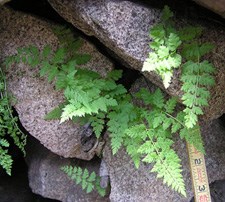|
Even though Arches National Park is a desert, there are almost 500 different plant species that live here. The conditions can be harsh with only four to thirteen inches (ten to thirty-three centimeters) of precipitation a year. The temperatures can range from -1 degree Fahrenheit (-18 degrees Celsius) to 116 degrees Fahrenheit (47 degrees Celsius). Plants have adapted to these conditions in a variety of ways. These adaptations are grouped in three categories: drought escapers, drought resistors and drought evaders. HOW TO PLAY: There are 6 questions in this activity. To advance to the next question, choose one of the photos below that best matches the plant adaptation described. Drought escapers are plants that take advantage of good growing conditions when they exist. For example, these plants will grow when there is enough water. Seeds of these plants may wait years until there is a rainstorm, and then grow. An example of this kind of plant would be one that blooms and goes to seed before the temperatures soar over 100 degrees Fahrenheit (38 degrees Celsius) in the summer. 1. Which plant below best illustrates a drought escaper?
| |
Last updated: July 1, 2021

.jpg?maxwidth=1300&maxheight=1300&autorotate=false)
